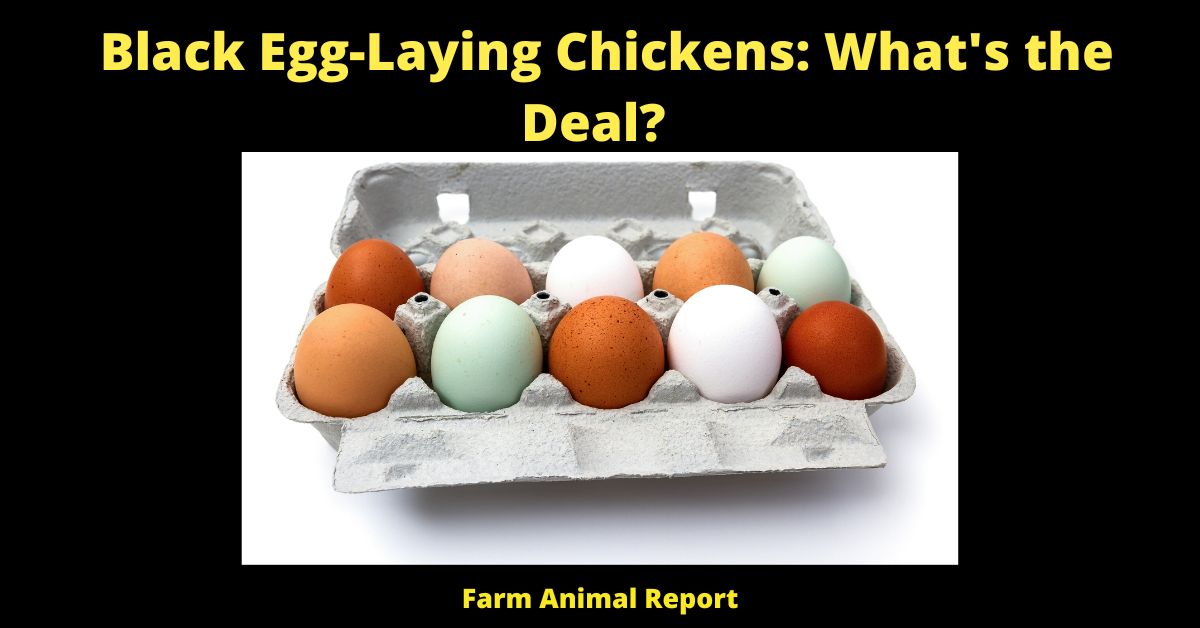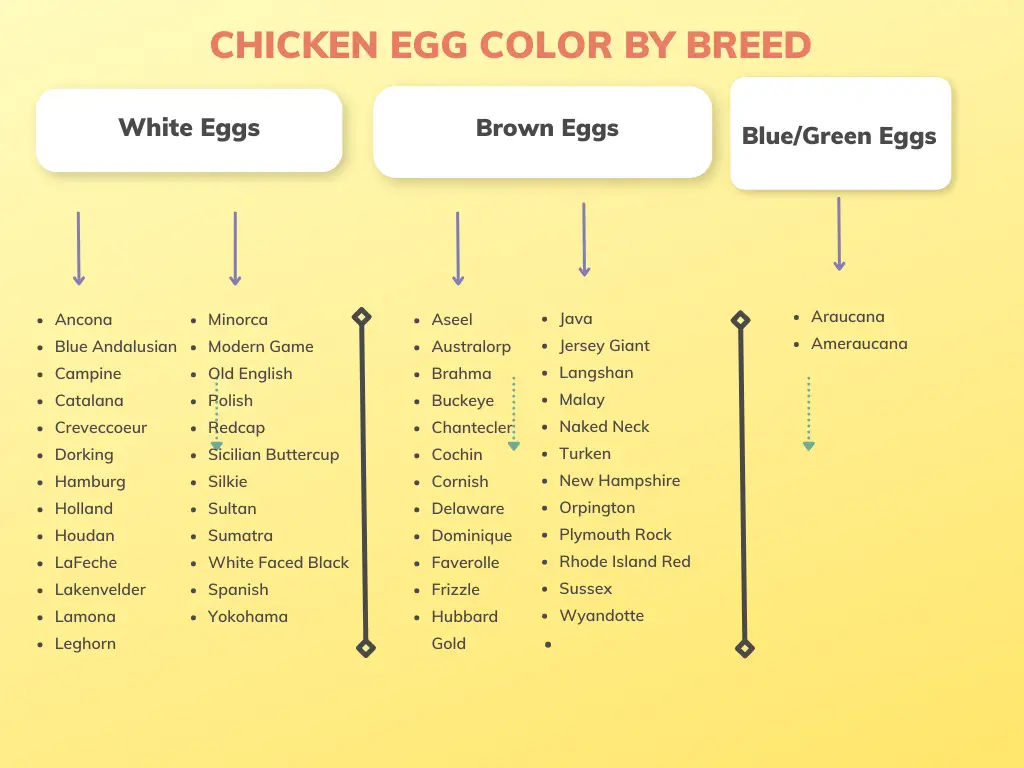Have you ever seen a chicken that lays black eggs? No, us neither. That’s because such chickens don’t exist… or do they? In this blog post, we will explore the world of black egg-laying chickens and find out what’s really going on. Are these strange birds just a figment of our imagination, or is there something more to them? Stay tuned to find out!
Chickens that lay Black Eggs?
The vast majority of chicken breeds lay brown eggs, with white being the second most common egg color. Blue and green eggs are relatively rare, but there are a few breeds that produce these shades of eggs on a regular basis.

However, black eggs are not found in nature and are not produced by any breed of chicken. So, if you come across a carton of black eggs at the grocery store, you can be sure that they are not from a chicken breed that lays black eggs naturally.
Check Out Amazon for Educational Resources for Breeding Chickens
While black chicken eggs are certainly beautiful, it is important to note that there are no chicken breeds that lay black eggs. The pigmentation of chicken eggs is determined by the breed of hen, with each breed having a different range of colors.
For example, Ameraucanas (Easter Eggers) can lay blue or green eggs, while Marans lay dark brown eggs. However, it is not possible for any chicken rare breed to lay black eggs. This is because the genetic mutation that would be necessary to produce black pigment does not exist in chickens. So, if you come across a black egg, it is likely that it was laid by a wild bird or a non-chicken species such as a duck or goose.
What determines the Color of a Chickens Egg?
The color of a chicken’s egg is determined by the pigments that are deposited on the shell during the final stages of egg production. The most common pigment is called biliverdin, which gives eggs a bluish-green color.
Other pigments include porphyrins, which produce brown or red eggs, and xanthophylls, which produce cream or tan-colored eggs. While the exact mix of pigments varies from chicken to chicken, the overall hue of the egg is determined by the breed of the bird.

For example, Ameraucanas and Araucanas lay blue eggs, while Marans lay chocolate-brown eggs. Ultimately, the color of a chicken’s egg is determined by a complex interplay of genetics and environment.

. Most chicken breeds lay white eggs, but there are some that lay brown, blue, or green eggs. The color of a chicken’s egg is determined by the pigment cells in the hen’s oviduct, which is the tube that leads from the ovary to the outside of the body.
The egg gets its color when it passes through the oviduct and picks up pigment from these cells. The amount and type of pigment in the cells will determine the final color of the egg. For example, hens that lay brown eggs have more reddish-brown pigments in their cells, while hens that lay blue eggs have bluish-green pigments. Chicken breeds that lay white eggs don’t have any pigment in their cells.
Why is the Outside Color of an Eggshell different than the inside?
You may have noticed that the outside of an eggshell is usually a different color than the inside. For example, chicken eggs typically have white shells with yellow insides, while duck eggs have brown shells with white insides. So why is this?
It all has to do with the composition of the eggs. The outer layer of an eggshell is made up of calcium carbonate, which is a white substance. The inner layer of the shell, on the other hand, is thin and porous, and contains a pigment called biliverdin. This pigment is responsible for the typical yellow color of the egg yolk.
So why do duck eggs have brown shells? This is due to the presence of a protein called porphyrin, which gives the shell a brownish tint. Porphyrin also has antimicrobial properties, which helps to protect duck eggs from bacteria and other contaminants.

In conclusion, the different colors of an egg’s shell are due to variations in composition. The outer layer is typically made of calcium carbonate, while the inner layer contains biliverdin and other pigments. In some cases, such as with duck eggs, proteins can also contribute to the color of the shell.
What purpose does Porphyrin serve in eggshells?
Porphyrin is a molecule that serves several important functions in the body, including helping to produce energy and remove toxins. It is also found in eggshells, where it plays a role in protecting the developing embryo.
Porphyrin molecules are arranged in a specific way that makes them very good at absorbing light. This helps to protect the embryo from harmful UV rays. Porphyrin is also involved in the process of calcium carbonate deposition, which is essential for hardening the eggshell. Without porphyrin, eggshells would be much thinner and more fragile, making them more likely to break during incubation.
What purpose does biliverdin serve in eggshells?
Before a baby bird can take its first breath of fresh air, it must first break through its eggshell. This may seem like a simple task, but the shell is actually a complex structure that serves several important purposes.
One important compound found in eggshells is biliverdin. Biliverdin is a green pigment that gives eggshells their characteristic color. In addition to being visually appealing, biliverdin also helps to protect the developing embryo from harmful ultraviolet rays. Studies have shown that biliverdin can absorb up to 95% of UV light, making it an important defense against sun damage. In addition to protecting against UV radiation, biliverdin also has antimicrobial properties, keeping bacteria and other pathogens out of the egg.
Without biliverdin, eggs would be more susceptible to bacterial contamination, posing a serious threat to the developing embryo. Thus, while it may seem like a simple compound, biliverdin plays an essential role in keeping baby birds safe and healthy.
What purpose does protoporphyrin serve in Chicken Eggshells?
Protoporphyrin is a natural pigment that gives eggshells their characteristic color. In chickens, this pigment is produced in the liver and deposited in the eggshell during the final stages of formation. While its exact function is still not fully understood, protoporphyrin is thought to play a role in protecting the developing embryo from sunlight.
The pigment is also believed to help regulate the temperature of the egg, keeping it warm enough for development but cool enough to prevent overheating. In addition, protoporphyrin may help to strengthen the eggshell and prevent it from being damaged by bacteria or other agents. Whatever its exact function, it is clear that protoporphyrin plays an important role in the development of chicken eggs.
What purpose does calcium carbonate serve in Chicken Eggshells?
Chicken eggshells are composed of about 94% calcium carbonate. Calcium carbonate is a white, odorless powder that is widely used in many industries. It has a number of uses, including being a significant component of construction materials such as cement, asphalt, and concrete. It also has industrial applications such as being used as an abrasive, filler, or whitener. In addition, calcium carbonate is a key ingredient in agricultural lime, which is used to improve soil fertility.
And this doesn’t even scratch the surface of all the things that calcium carbonate is used for! So it’s no wonder that chicken eggshells are made mostly of this amazing substance. As for what purpose calcium carbonate serves in chicken eggshells specifically, it helps to make the shells strong and resistant to breakage.

This is important because it protects the developing chick inside from harm. It also makes it easier for the chick to hatch by providing a bit of give when it needs to peck its way out. So next time you enjoy some scrambled eggs or an omelet, remember to thank calcium carbonate for helping to make it possible!
What is the bloom when chickens are Laying Eggs?
When chickens lay eggs, they go through a process called “blooming.” During blooming, the chicken’s body produces a waxy substance that coats the egg. This substance helps to protect the egg from bacteria and keeps it from drying out.
The bloom also makes the egg more slippery, which helps the chicken to push it out of the shell. Once an egg is laid, the bloom will gradually disappear. However, if an egg is not properly cleaned, the bloom can become hard and crusty. This can make the egg difficult to hatch or even cause it to rot. For this reason, it is important to clean eggs as soon as possible after they are laid.
Since the pigment is in the Bloom, Washing the Egg will Remove some of the Color.
What purpose does fibromelanosis have in Chicken Eggshells?
Chicken eggshells are composed of two main layers: the thin outermost layer called the bloom and the thicker inner layer called the fibrous layer. The fibrous layer is made up of proteins and minerals, including calcium carbonate. This layer provides strength and support to the egg. The outer bloom is a protective layer that helps to keep the egg clean and free of bacteria.
It is composed of a protein called keratin. Fibromelanosis is a condition that results in black spots on chicken eggs. While the cause of this condition is not fully understood, it is believed to be a genetic mutation. Some researchers believe that fibromelanosis may provide some benefits to chickens, such as increased immunity to disease or improved thermal regulation.
However, more research is needed to confirm these potential benefits. In most cases, fibromelanosis does not have any negative effects on the quality of chicken eggs. Therefore, it is not considered to be a serious problem for chicken farmers
Can Feed affect the color of Chicken Eggshells?
It is a common question whether the feed given to chickens can affect the color of their eggshells. The answer is yes, it can! However, it is important to note that the bird’s genetics also play a role in shell color. For example, White Leghorn hens typically lay white eggs, while Ameraucanas and Araucanas lay green or blue eggs.
There are two main types of pigments that can be found in chicken eggshells: carotenoids and biliverdin. Carotenoids are red, yellow, or orange pigments that are synthesized by plants and algae, and are then passed on to animals when they consume plant matter. Biliverdin is a green pigment that is produced when the chicken’s body breaks down old red blood cells.
A chicken’s diet can affect the amount of these pigments that end up in their eggshells. For example, if a chicken eats a lot of greens, they will likely lay an egg with a darker shell color due to the increased carotenoid content. In contrast, a chicken that does not eat many greens will likely lay an egg with a lighter shell color. So, while genetics play a role in shell color, diet is also an important factor to consider.
What are the Physical Characteristics of the Ayam Cemani Chicken Breed?
The Ayam Cemani is a chicken breed originating from Indonesia. It is an unusual chicken in that it is completely black, including its feathers, beak, wattles, and earlobes. The chicken’s black color is the result of a genetic condition called fibromelanosis, which causes a build-up of melanin pigment in the skin.
While the Ayam Cemani is not the only breed of chicken with this condition, it is by far the most popular and well-known. The breed was first introduced to Europe in the early 2000s and has since become a prized possession among chicken enthusiasts.
Thanks to its rarity and striking appearance, the Ayam Cemani commands a high price tag; a single bird can sell for over $2,000! Despite its cost, the Ayam Cemani is considered to be a relatively docile and low-maintenance bird, making it a good choice for those looking for a pet chicken. For anyone interested in trying something truly unique, the Ayam Cemani is definitely worth checking out.
What color eggs does the Ayam Cemani Chicken Breed lay?
The Ayam Cemani is a breed of chicken that is native to Indonesia. It is now also in the United States> The breed is known for its distinctive black plumage, which is the result of a genetic condition called fibromelanosis.
This condition causes the chicken’s body to produce extra melanin, resulting in black feathers, skin, and organs. The Ayam Cemani is also known for its unusually long lifespan, with some chickens living for 15 years or more.
The breed lays lite tan to brown eggs, which are about the same size as those of other chicken breeds. However, the eggs have a darker brown coloration due to the higher concentration of melanin in the Ayam Cemani’s feathers.
Does the Color of the Eggshell Have an Effect on the Nutritional Value of the Egg?
The color of the eggshell does not have an effect on the nutritional value of the egg. However, it can be an indicator of the chicken’s diet. Chickens that are fed a diet of corn and soybeans tend to lay eggs with yellow or pale-colored shells.
Chickens that are fed a diet of green plants and insects tend to lay eggs with brown or dark-colored shells. The nutritional content of the egg is determined by the chicken’s diet, not by the color of the shell. The color of the shell is simply a reflection of what the chicken has been eating and the genetics of the chicken Breed?
Final Thoughts – Chickens that lay Black Eggs?
While there are no chickens that lay black eggs. There are some that lay various shades of Brown. Some of the Maran Chickens Breeds lay the darkest Brown eggs.





